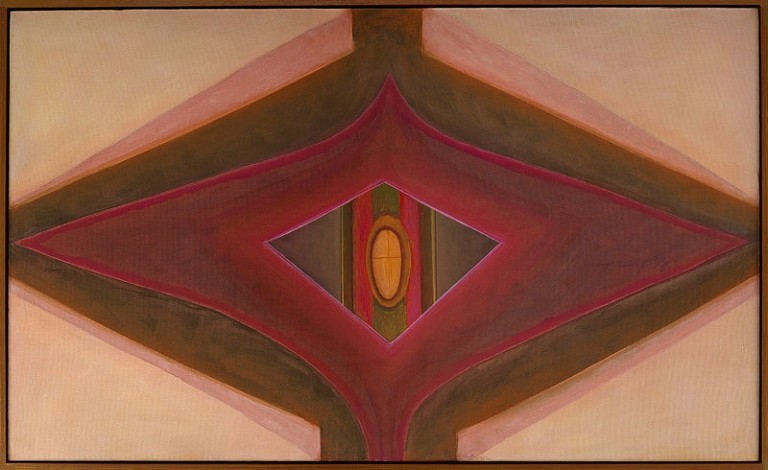
The Brooklyn Rail: Ida Kohlmeyer: Cloistered
May 18, 2020 - William Corwin for The Brooklyn Rail
Think of all the meanings, nuances, and implications embedded in the word “cloistered,” and they reside here in Ida Kohlmeyer’s series of that title, executed in the late 1960s and now on virtual view at Berry Campbell Gallery through May 23. The earliest of these works were produced in 1968, the same year Stanley Kubrick’s 2001: A Space Odyssey came out, and many of them have the wary and watchful quality of the monotonic computer HAL, which loses faith in its human chaperones in Stanley Kubrick’s iconic film.
In Kohlmeyer’s paintings, there is a protected conceptual space lying just below the surface of the canvas, under a layer of sparingly applied oil paint and graphite. This is the imaginary volumetric structure for most of Kohlmeyer’s imagery in this series: a somber interior zone peeks out through a central oculus, or blossoms in an undulating vegetal sprout. The relationship of painting to the viewer is reversed as the spectator is surveilled by an alien eye. Kohlmeyer paints this cloistered presence into her works with varying degrees of directness. Black Insert” (1968) simply presents a black diamond with a lightly incised rectilinear form floating, shadowy, within it. By contrast, the final painting in the show, Cloistered (1969), stares out obsessively from the back of the gallery. A cross is carefully etched on the lozenge of the eye, a detail that makes the viewer feel as if the painting broodingly judges them. Kohlmeyer's reclusive entities carry with them all the accompanying angst, sadness, concealment, and, at times, anger, that arise from an unwilling sequestration.
There’s also a more immediate structural interpretation: most of the works are geometric, but with relaxed hand-drawn lines, and play on the symmetry and proportion of medieval walled gardens—the literal cloister. The picture plane is quartered or in some cases halved, and has a central element that serves as a point of arrival for the vectors of the painting and attracts the eye of the viewer. In this central position, Kohlmeyer typically substitutes something dark and glowering for the babbling fountains and cheerful plantings most of us know from the Cloisters museum in Fort Tryon Park. Of the paintings on view, the most Kubrickian watcher of all is the bisected black cornea and dilated pupil of Cloister #5 (1968). But there are exceptions, and Kohlmeyer does occasionally traffic in less emotionally fraught effects. Cloistered #12 (c. 1969) culminates in a colorful black/blue and pink/yellow floret, while Suspended (1968), with its palette of bright grass greens, iris, and greenish yellow, is very upbeat, and seemingly Easter-themed, including a central egg-shaped form decorated with arcs and bands. Kohlmeyer’s sculptures are variations on the theme of the paintings, but play with the idea of multiplicity. Canvas stretched over wood, they are paintings moved off the wall and placed in space, toying with a front and back in three dimensions. Stacked #1 (1969), is a tower of three cubes, with fecund buds centered on each surface: the painting now overlooks the entire room like a cyborg lighthouse.
There are obvious relationships that can be drawn between Kohlmeyer’s paintings and human anatomy—eyes and other organs are most obvious. But the repetitive crosses and ecclesiastically-specific architectural titles reiterate a spiritual and symbolic subtext that moves beyond mere floral or organic models. It is hard to say what the message is—the works themselves, juxtaposing bright colors with a forlorn presence, may not have decided for themselves. Before she created the works on view at Berry Campbell, Kohlmeyer’s style was Abstract Expressionist, influenced by Rothko and Gorky. The artist also studied under Hans Hofmann in Provincetown in the mid-fifties. Her later work would go on to explore ideas of pattern and multiplicity—Berry Campbell offers a striking example of this period in Color Stripes (1980). The Cloister series and its auxiliary works seem to represent an interlude of sorts, during which the artist explored a closer, but riskier, engagement with the viewer. These paintings have a pathos to them, but never veer into the outright horror or fury of Lee Bontecou’s dark blank lacunae from the late 1950s and early 1960s. As with all series carried out over just a few years, it’s impossible to tell if Kohlmeyer could have continued to walk the fine line between gripping emotional connectedness and over-the-top sentimentality, but for this short span, she certainly pulled it off.
Back to News
